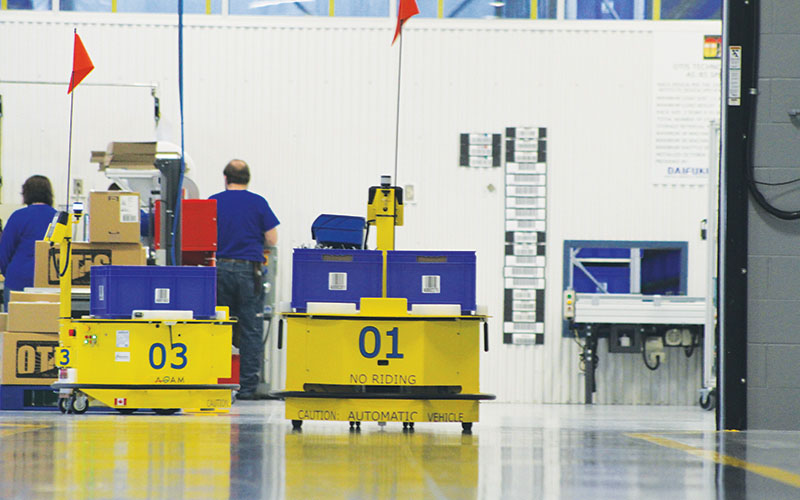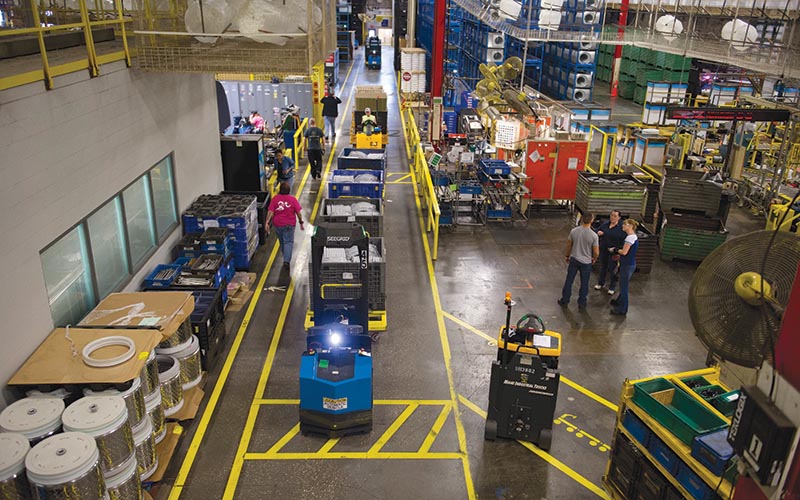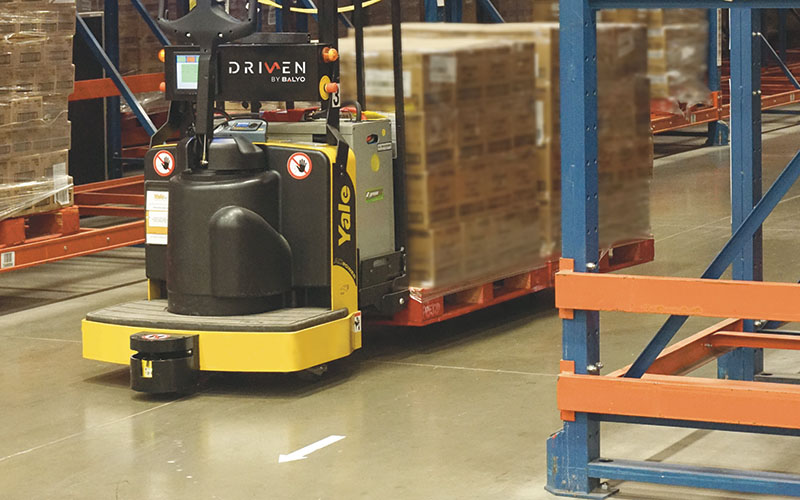New hires entering the materials handling world have access to an assortment of autonomous industrial vehicle technologies that their counterparts did not a decade ago. In fact, the pace of advancement in navigation, sensors and capability has tracked with that of self-driving cars.
Consider that in DARPA’s Grand Challenge in 2004, the $1 million prize went unclaimed after none of the 100 autonomous vehicles that entered could cover more than 11 miles of the 150-mile desert course. Today, Tesla’s autonomous technology alone has logged well more than a billion miles, including crowded city centers.
For the purposes of this story, the acronym AGV will refer broadly to automatic guided vehicles—which have been used in industrial settings for half a century—as well as autonomous mobile robots, self-driving vehicles, and autonomous industrial vehicles in general. It’s also important to note that hardware is just one side of the AGV coin, with software to coordinate movement and communication on the other.
As such, AGVs are not at all merely forklifts that don’t require a driver. Given their configurability for loads of all sizes and their ability to be closely integrate with warehouse management and execution systems, you could argue they’re more closely related to conveyor technologies than heavy equipment.
Michael Fleming, product leader of the self-driving technology group for SSI Schaefer Systems International, says even industry veterans sometimes have difficulty understanding AGV technology and how it might apply to their operation. It’s understandable that those who view an AGV as just a forklift might think they can replace eight forklift operators with eight AGVs.

“If you look at an AGV as a vehicle, you’re missing 80% of an effective material flow system,” Fleming says. “How will the system be implemented? How will you know eight is enough, or too many? You need a holistic view of the AGV as a piece working in harmony with the larger system.”
What’s under the hood
Fleming breaks down the components of autonomous vehicles into three technology categories: localization, navigation and load handling. The first two are often conflated, he says, but how to determine where you are is not the same as how you drive.
An AGV could have a localization system based on magnetic tape in the floor, but it might also have an object avoidance system that allows it to safely depart from the tape track. Or, it could use simultaneous location and mapping (SLAM) without active obstacle avoidance.
Fleming emphasizes that there’s no single localization, navigation or load handling technology that’s better than any other—the application determines what makes sense. A key benefit to modern and future AGV technologies, he says, is the standardization of the various servos, motors, drives, sensors, computers and attachments that create a solution.
As opposed to the AGVs of yesteryear, standardized modules support customization while preserving ease of connectivity, maintenance and adaptability. “Standardization is a fundamental driver underneath the Internet of Things and Industry 4.0,” adds Fleming.
Laura McConney, marketing specialist for JBT Corp., says the flexible capabilities of each individual unit means fewer vehicle types can address more applications.
“Sensors and 3D cameras can detect where fork pockets are for different types of pallets,” she explains. “If you’re handling numerous different materials you only need one type of vehicle, not four, to handle four different transport platforms.”
However, in terms of official standards and regulations, Fleming says there’s a lot of work to be done. Right now, standards bodies like EN and ANSI lack discrete levels, which Fleming likens to applying the same standards to a remote control car and a tractor trailer.
“A regular person with a license can drive on the same road with a bus driver and a trailer of nuclear waste,” says Fleming. “There are different tests and layers of control to identify different levels of complexity in each application. With AGV standards now, there aren’t those levels.”
In the meantime, safety is a central consideration in the design and deployment of any AGV. According to John Clark, director of marketing and communication for Dematic North America, it’s not like a Google car, which assumes someone holding the wheel can intervene. The machine needs to do everything on its own.
Don Heelis, sales manager for Cimcorp, says AGVs create a safer environment than one with, for example, a fleet of forklifts working near pedestrians.
“If you’re not paying attention, someone can get seriously hurt, but AGVs don’t have bad mornings or hangovers,” Heelis says. “It’s a factor that’s not necessarily obvious until you get into a facility. It’s amazing how humans start to interact with this equipment once they become comfortable with it. I’ve seen customers who use bicycles to cover distances in a large facility, and they slalom between AGVs without a second thought. Doing that around human-operated forklifts could be bad for your health.”
Whatever the array of sensors employed—GPS, SLAM, planar, 2D or 3D LIDAR (light detection and ranging)—the goal is to collect as much relevant data as possible about the AGV’s environment so it can operate safely and independently.

“If you want the machine to drive itself, you want the maximum amount of information to make the best decision,” says Jeff Christensen, vice president of products for Seegrid. “The software making those decisions can’t understand the world without sensors and because software improves faster than hardware, it could be hindered by a lack of data. That’s why cameras have become a leader in terms of data density.”
The grand ballet
The goal of many modern AGVs is to perform tasks in an independent, highly autonomous fashion. This means reacting to a dynamic environment, communicating with one another, and even self-diagnosing variations in vibration or temperature that call for preventative or other maintenance.
“AGVs can function in a simple system with just their own onboard electronics and software, or be part of a full factory system that requires AGV traffic management and potentially interfaces with upper level manufacturing systems,” says Keith Soderlund, vice president of sales for Creform.
“AGVs often interact with conveyors and stationary robots and are part of the plant’s process equipment. A properly designed and maintained system functions so smoothly that it becomes an integrated portion of the facility’s manufacturing infrastructure.”
Not all AGV systems need to be integrated with broader warehouse software systems, but nearly all are governed by a fleet or traffic management software layer.
“It’s how machines know what to move and where to move it, with full system-level coordination,” says Christensen. “It’s a grand ballet of machines in a warehouse fluidly moving things exactly as they need to. They should also be proactive as opposed to reactive, ensuring you have capacity at the time of need. It aligns with lean manufacturing principles to operate in a more tightly coordinated way than you ever could with people.”
The fleet management system issues missions for activities in a warehouse or production environment, but it does not micro-manage. Each AGV is capable of decision-making, and they can also communicate with one another to work out efficient solutions to a given challenge.
McConney offers the example of product coming off the line and being transported by AGV to the warehouse. Vehicles need to go down aisles, and in years past, one vehicle would go down the aisle to perform a putaway while the next vehicle waited.
“It knew it needed to go in there eventually, but would just sit until the other unit’s task was complete,” says McConney. “Now, there are ways to work around one another, perhaps sneaking into the same aisle if it can get in and out before the first AGV is done, or it can jump right in as soon as the other vehicle is clear without waiting for confirmation from the fleet manager. This can shave precious seconds and minutes off each task.”
In fact, an AGV can even be relocated to another facility and start working alongside fellow units after a quick introduction to that facility’s higher-level fleet management.
“AGVs are incremental automation,” says Clark. “For a facility that has no automation, it can be daunting. They can’t afford to close down and reconfigure for a huge paradigm shift. With an AGV, you don’t have to rip and replace with an automated storage and retrieval system (AS/RS). There’s no need for a big conveyor system. An AGV can use existing infrastructure in a small area and grow with you.”
These operations will also find the AGV helps with efficiency upstream and downstream of where it’s deployed, Clark adds. If an AGV is expecting to pick up a pallet, the processes to present that pallet had better be ready, and the same goes for that pallet’s destination. “AGVs clean up one section of the house,” he says, “and by their nature other areas get cleaned up.”
Heelis adds that this dynamic allows the fleet management system to assume the role of labor manager. For example, an AGV interfacing with a manual work cell can help regulate the pace of work in that cell. “Productivity gains can be achieved from that,” he says. “Over the course of an eight-hour day, maybe that manual worker can do the work in five hours, but an AGV can spread that out and take away the ‘hurry up and wait’ effect.”
Familiar functionality
Anyone with a smart phone has likely experienced software updates that unlock new functionality of the device. Similarly, AGVs can benefit from what Christensen calls a “rejuvenation of the value of a thing you bought previously.” In fact, he says AGVs are often built with hardware that’s not yet even supported by software in anticipation of future functionality.
“From a deployment perspective, it’s cheaper to put those components in now and then do a software update,” says Christensen. “Then, the automated vehicle I bought last year suddenly has features it didn’t before. That sort of iPhone model in this industry is a huge shift.”
Along the same lines, hybrid or dual-use AGVs preserve the familiarity of standard forklifts while adding automation to address non-value-added travel. According to Lou Micheletto, manager of integrated solutions for Yale Materials Handling Corp., AGVs were historically purpose-built to do one thing and one thing only.

“Now, there’s always something different,” says Micheletto. “By building a conventional lift truck and then adding guidance and communication, it’s able to function autonomously or, in those unanticipated times like the hot order that comes in at 4:45 p.m., a human can jump on and operate, then send it back on the virtual path.”
Micheletto says clients purchase hybrid equipment with the expectation it will run autonomously 90% of the time. However, the conventional functionality is regularly needed at the end of the month, or end of a shift, or other exceptions they never anticipated.
Just as users benefit from the occasional unexpected functionality unlocked by a software update, Micheletto says even AGV manufacturers are sometimes pleasantly surprised. For example, as they go about the business of ensuring a clear path, sensors pick up a huge amount of data that’s typically discarded if not needed.
Instead, Micheletto says the units can now use that data for “intelligent pallet detection.”
As an AGV drives past a pre-defined area at the end of a lane, it can see whether or not a pallet is there. The AGV will then pick it up and deliver it, or if loaded, it will send a message to another unit, Micheletto says. In normal circumstances, a signal would need to be sent to the unit to initiate that transport.
“With intelligent pallet detection, there’s no need for additional communication with anything,” Micheletto says. “Without any interface to IT systems, you can move pallets around based on data. This allows customers to try a robotic lift truck without ever having to tap IT.”
The development of AGVs in warehousing and distribution is just beginning, and Christensen suggests the industry is at a fundamental inflection point. “It’s a great time to be coming into this industry,” he says.
“This kind of change is exciting, and new materials handling professionals can ride the wave as AGV technology evolves and grows.”
Companies mentioned in this article:
- Creform
- Cimcorp
- Dematic
- JBT Corp.
- Schaefer Systems International
- Seegrid
- Yale Materials Handling Corp.
Article topics








